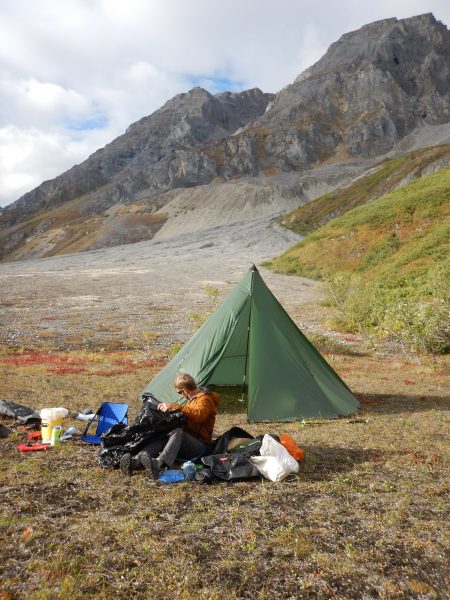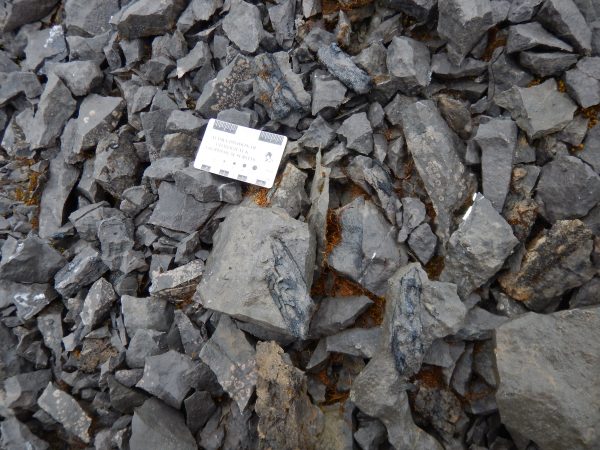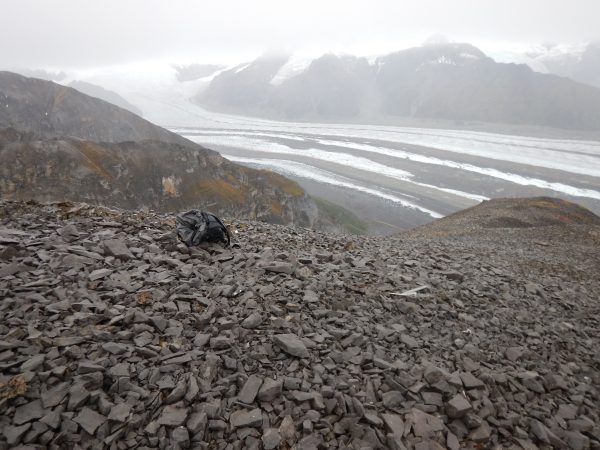Prehistoric reptile one mile above McCarthy
October 5, 2017
Ned Rozell
907-474-7468

In 1963, 23-year-old geologist David Whistler sat down for lunch on a rocky hilltop one mile above Kennicott Glacier. With one hand on his sandwich and the other on his miner’s pick, he flipped over rocks. One of them made him pause. Embedded in the stone was a row of sharp teeth.
Though he was there to map the geology of the area, Whistler picked up the rock fragment, a little longer than his palm, and placed it in a cotton bag. Among a few hundred other words in his field notes for the day, he wrote, “Fossil. Reptile.”
Fifty-four years later, drawn by that hardened jaw and Whistler’s field notes, Pat Druckenmiller and Mike Loso stood on the same mountaintop.
“As we came up to the boulder field, little blue things were staring at me — they were bones,” said Druckenmiller, a paleontologist and curator of the earth science collection at the University of Alaska Museum of the North. “This whole outcrop was littered with ichthyosaur specimens.”
Ichthyosaurs were ocean-dwelling reptiles swimming at the time of the dinosaurs. The one Whistler found looked something like a giant dolphin, perhaps 20 feet long.
Druckenmiller, an expert on ichthyosaurs, said less than a half dozen have been found in Alaska. This August, he responded with enthusiasm to a request from geologist Chad Hults of the National Park Service to follow up on Whistler’s find. Along with Wrangell-St. Elias’s Mike Loso, Druckenmiller took a short flight from McCarthy and camped near Kennicott Glacier. The next day, they ventured out with field notes Whistler had written on Aug. 18, 1963.
Druckenmiller did not collect the rocky bones of the creature this summer (a permit is required to remove fossils from public land) but was enthused by what he saw on the hilltop.
“There’s a disarticulated ichthyosaur skeleton on top of this ridge and there’s a lot more to find,” said Druckenmiller.

Whistler, now 77, lives in Bend, Oregon. He spent the summer of 1963 tenting in McCarthy, which then had a population of six. Every day, a helicopter would take him and a partner out to map rock outcrops as part of a U.S. Geological Survey team.
Then a graduate student at the University of California Riverside, Whistler’s interest in the ichthyosaur jaw hinted at his future career. He later became a paleontologist with the Natural History Museum of Los Angeles County. At the beginning of his career in 1963, his job was to map groups of rocks in a quest to determine the source of the Kennicott area's copper.
“We were not allowed to goof off and grab fossils. I had to get down to (Hidden Creek Lake, for helicopter pickup),” Whistler said by phone from Bend. “But I wrapped (the jaw) and put it in a bag with 40 other pounds of rock.”
Whistler remembered how the theory of plate tectonics had not yet emerged in 1963, so he and his mapping partner puzzled at how tropical limestone had made it to a mountaintop in Alaska. So, how did a toothy monster from a prehistoric ocean make it to a rocky mountaintop 6,000 feet in the sky?
The ichthyosaur might have swam through reefs in the South Pacific. When it died, its carcass settled in mud that became limestone. Earth’s moving crustal plates rotated the sheet of rock northward, where it collided with the Alaska subcontinent.
For hundreds of millions of years, the ancient creature rose slowly to the sky, absorbing snowfalls, rain and sunshine. Its petrified bones are still ascending with the Wrangell Mountains.

Tantalized by what he saw on the hilltop, Druckenmiller hopes to go back in 2018 with helicopter support.
“There’s Triassic rock there all over the bloody place. It’s pretty easy to spot. If we can get up there, I’ll bet you anything we’ll find more,” he said.
Whistler, remembering his fun summer of 1963, agreed that there are more reptiles in those hills.
“We saw bits and pieces of bone all summer long,” he said.
Since the late 1970s, the University of Alaska Fairbanks' Geophysical Institute has provided this column free in cooperation with the UAF research community. Ned Rozell is a science writer for the Geophysical Institute.


